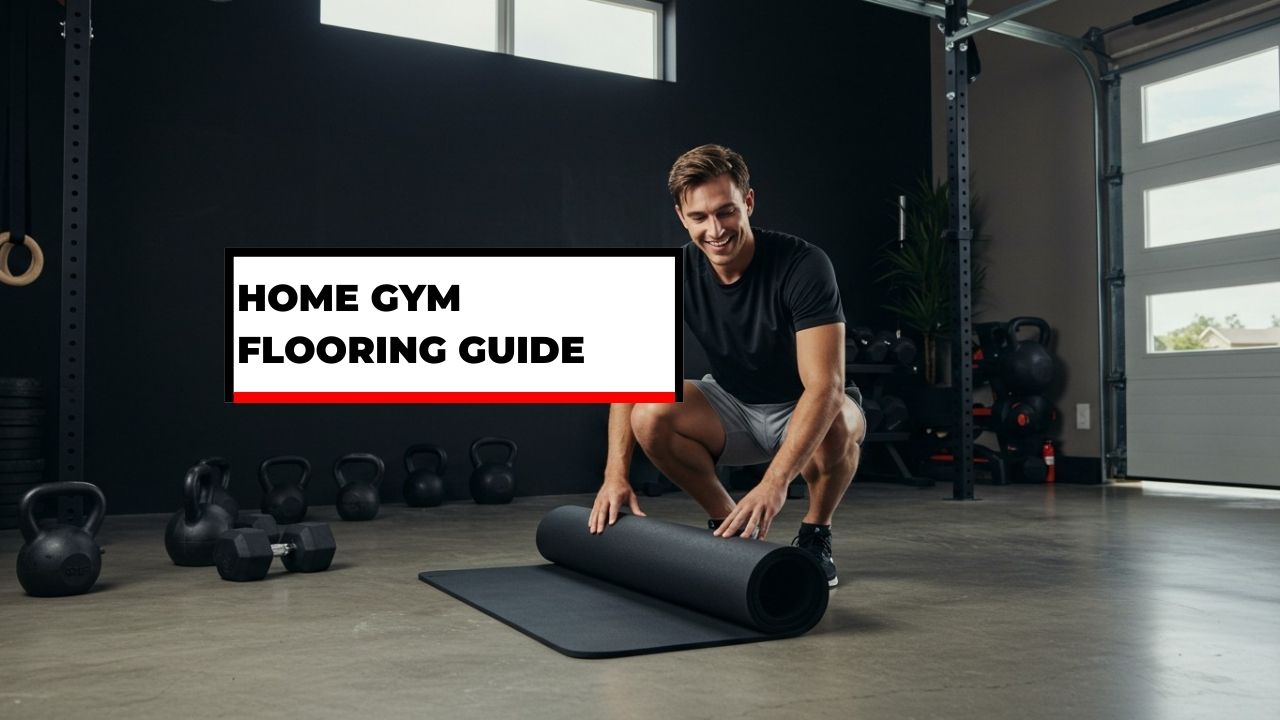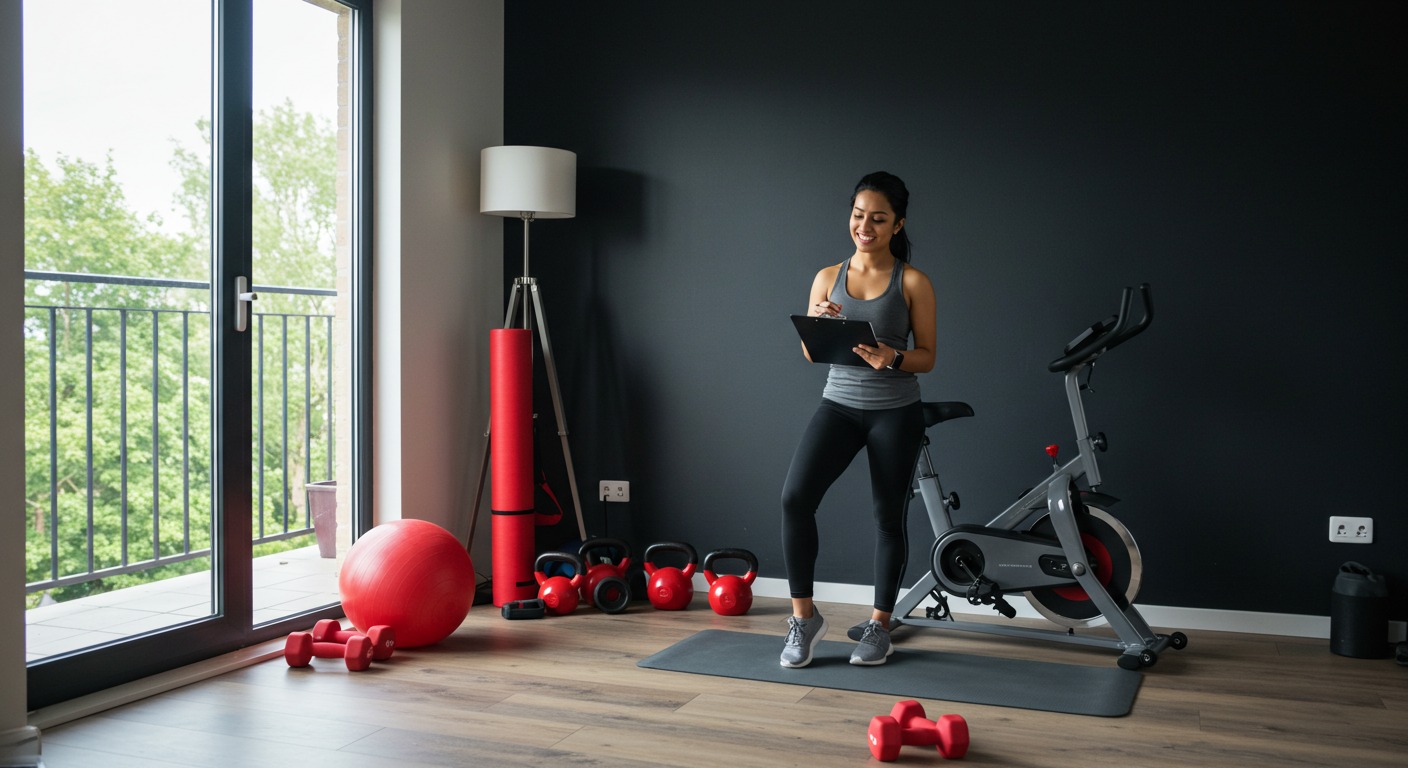Disclosure Information
This blog contains affiliate links. If you make a purchase through one of these links, our team may earn a commission at no extra cost to you. Learn more. Thanks for your support!
Creating the perfect home gym starts from the ground up—literally. The right flooring not only protects your existing floors but also provides comfort, noise reduction, and durability for your workouts.
As home fitness continues to grow in popularity, with over 72% of fitness enthusiasts incorporating some form of home training into their regimen, the foundation of your workout space deserves careful consideration. Investing in proper gym flooring transforms both the functionality and psychology of your workout space.
This comprehensive guide explores the best home gym flooring options to help you make an informed decision for your fitness sanctuary.
The Quick Overview: Best Home Gym Flooring Options
- Best for Weightlifting: Rubber-Cal Elephant Bark Floor Mat
- Best Interlocking System: American Floor Mats Rubber Tiles
- Best Budget Option: BalanceFrom Puzzle Exercise Mat
- Best Cushioned Surface: ProsourceFit Extra Thick Puzzle Mat
- Best Lifting Platform: PRx Performance Olympic Platform
Factors to Consider When Choosing Home Gym Flooring

Before diving into specific options, consider these important factors that will guide your selection process:
Exercise Type
Your workout style dramatically influences your flooring needs:
- Weightlifting: Requires dense, thick flooring (minimum 3/8″) to protect against dropped weights and heavy equipment impressions
- Cardio: Needs shock-absorbing surfaces with moderate cushioning for joint protection during repetitive movements
- Yoga/Pilates: Benefits from softer, grippy materials for comfort during floor exercises and proper stability
- Mixed fitness: May require zoned flooring solutions with different materials for different exercise areas
Space Characteristics
The physical properties of your exercise space significantly impact your flooring selection:
- Basement settings may need moisture-resistant options with vapor barriers to prevent mold and mildew
- Upper floors require enhanced sound dampening capabilities to minimize disturbance to neighbors or family members
- Garage gyms need temperature-resistant materials that can withstand seasonal fluctuations without warping or degrading
- Indoor living spaces might prioritize aesthetic appeal and integration with existing home design elements
Budget Considerations
When calculating your budget, consider:
- Total square footage requirements
- Subfloor preparation costs
- Installation expenses (DIY vs. professional)
- Long-term durability and replacement frequency
- Potential resale value addition to your home
Types of Home Gym Flooring
1. Rubber Flooring
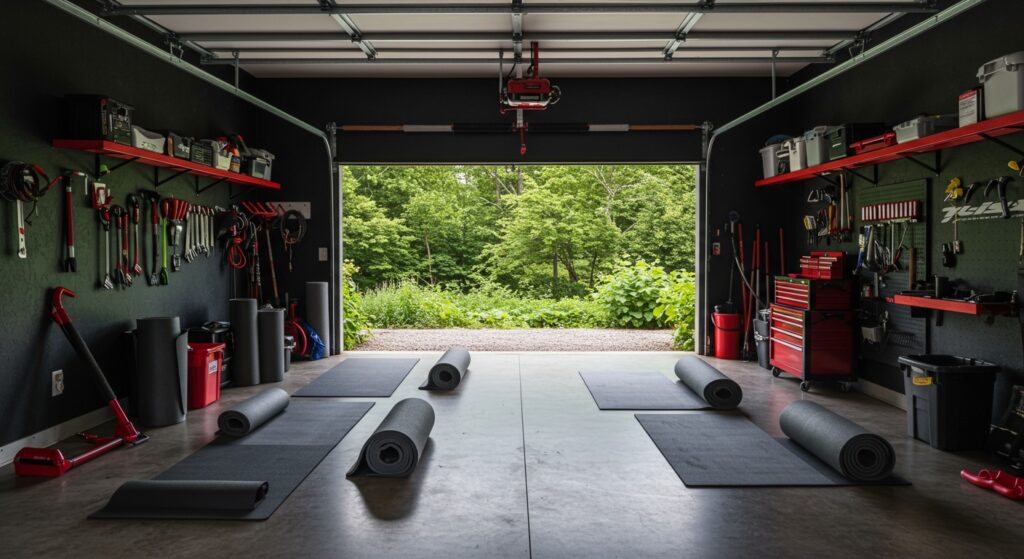
Rubber stands as the gold standard for serious home gyms, offering professional-grade performance for dedicated fitness enthusiasts.
Best For: Heavy weightlifting, garage gyms, and long-term fitness investments.
Benefits:
- Superior durability under heavy equipment
- Excellent sound and shock absorption
- Low maintenance with exceptional longevity
- Available in rolls, tiles, or mats
Drawbacks:
- Higher initial cost than foam options
- Potential rubber odor in new installations
- Heavier than alternatives, making installation challenging
Top Recommendations:
| Product | Thickness | Price Range |
| Rubber-Cal Elephant Bark | 3/8″ | $2.50-$4.00/sq ft |
| American Floor Mats Tiles | 8mm | $3.50-$5.00/sq ft |
Rubber-Cal Elephant Bark Floor Mat features recycled materials, various size options, and superior density for equipment stability.
American Floor Mats Tiles offer interlocking design for easy installation, excellent sound dampening, and precision-cut edges for secure connections.
2. Foam Tiles
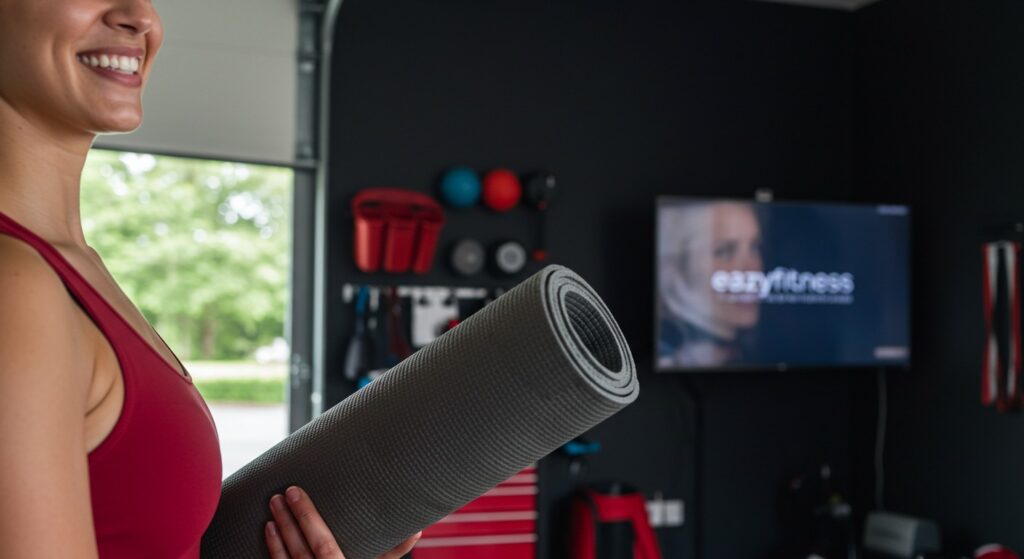
Foam tiles offer an affordable, lightweight option for casual exercise spaces and temporary setups.
Best For: Yoga, Pilates, bodyweight exercises, and temporary gym setups.
Benefits:
- Budget-friendly pricing
- Easy DIY installation with puzzle edges
- Comfortable underfoot for floor exercises
- Lightweight and simple to reconfigure
Drawbacks:
- Less durable under heavy equipment
- Can dent, creating permanent depressions
- May slide during dynamic movements
Top Recommendations:
| Product | Thickness | Price Range |
| BalanceFrom Puzzle Mat | 3/4″ | $1.00-$1.80/sq ft |
| ProsourceFit Thick Mat | 1″ | $1.50-$2.25/sq ft |
BalanceFrom Puzzle Exercise Mat provides moisture-resistant surface, interlocking design, and non-toxic, high-density foam construction.
ProsourceFit Extra Thick Puzzle Mat delivers maximum cushioning, non-slip textured surface, and comes in multiple color options.
3. Horse Stall Mats
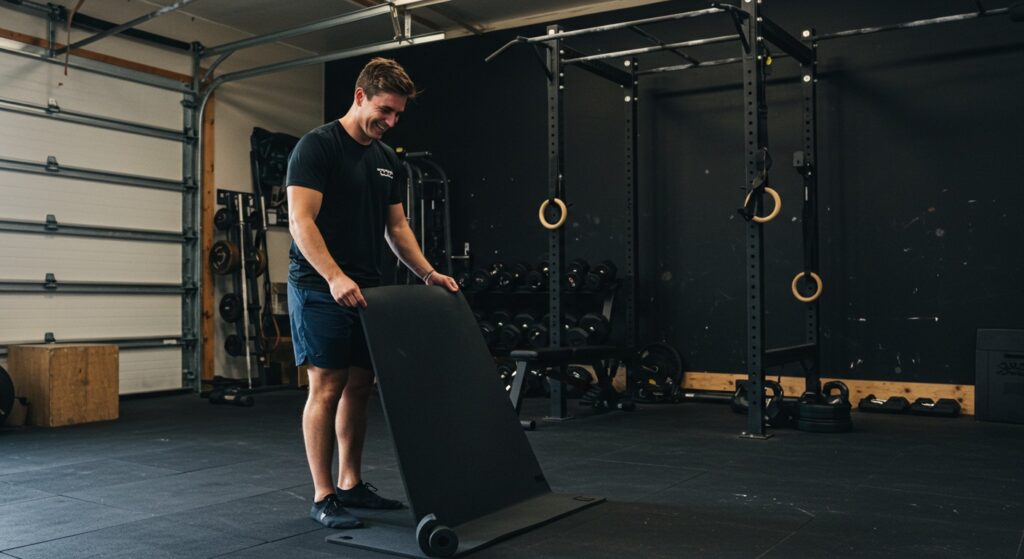
A popular budget option with serious performance capabilities that has gained significant traction in the home fitness community.
Best For: Powerlifting and heavy training on a budget.
Benefits:
- Exceptional durability rivaling commercial gym flooring
- Significantly lower cost than gym-specific products
- Widely available at agricultural supply stores
- Thick enough (typically 3/4″) for serious weightlifting
Drawbacks:
- Strong initial rubber odor
- Heavy and difficult to transport/install
- Limited aesthetic options (typically only black)
Top Recommendations:
| Product | Thickness | Price Range |
| Tractor Supply Co. | 3/4″ | $1.80-$2.20/sq ft |
| RAMM Horse Stall Mats | 3/4″ | $2.00-$2.50/sq ft |
Tractor Supply Co. Mats offer exceptional protection against drops, extremely durable construction, and are made from recycled materials.
RAMM Horse Stall Mats feature premium-grade rubber, better edge finishing, and enhanced resistance to curling over time.
4. Vinyl Flooring
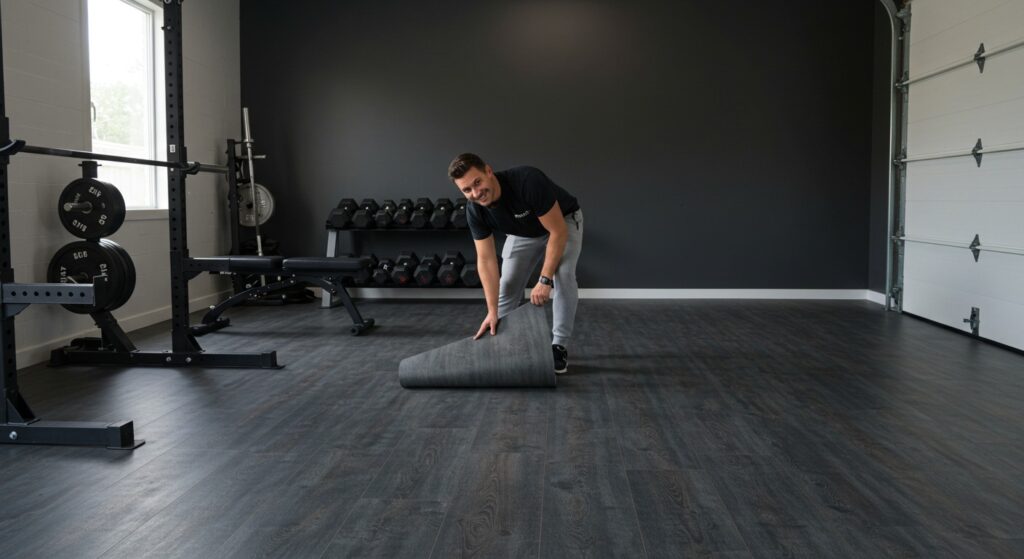
Vinyl offers a balance of durability and aesthetic appeal for multi-purpose spaces.
Best For: Multi-purpose spaces requiring both style and function.
Benefits:
- Modern, finished appearance
- Water and stain resistance
- Easy to clean and maintain
- Wide variety of design options
Drawbacks:
- Less shock absorption than rubber or foam
- May require additional underlay for protection
- Potential for damage from dropped weights
Top Recommendations:
| Product | Wear Layer | Price Range |
| TrafficMaster Allure | 20mil | $2.75-$4.00/sq ft |
| Armstrong Vivero Best | Diamond-infused | $3.50-$5.50/sq ft |
TrafficMaster Allure Ultra features integrated locking system, wood-look finish options, and waterproof construction.
Armstrong Vivero Best offers enhanced durability against scratches, wide range of designs, and 100% waterproof construction.
5. Carpet Tiles

Commercial-grade carpet tiles provide a comfortable, customizable option with practical advantages.
Best For: Yoga studios, stretching areas, and mixed-use spaces.
Benefits:
- Warm and comfortable underfoot
- Good sound absorption qualities
- Easy replacement of damaged sections
- Wide variety of colors and patterns
Drawbacks:
- Not suitable for heavy weightlifting
- Can absorb sweat and develop odors
- Requires more regular cleaning
Top Recommendations:
| Product | Features | Price Range |
| FLOR Carpet Tiles | Modular design | $5.00-$10.00/sq ft |
| Interface Commercial | Commercial-grade | $4.00-$7.00/sq ft |
FLOR Carpet Tiles offer stain-resistant construction, renewable sections, and diverse style options.
Interface Commercial Tiles provide low VOC emissions, antimicrobial options, and exceptional sound absorption.
6. Artificial Turf
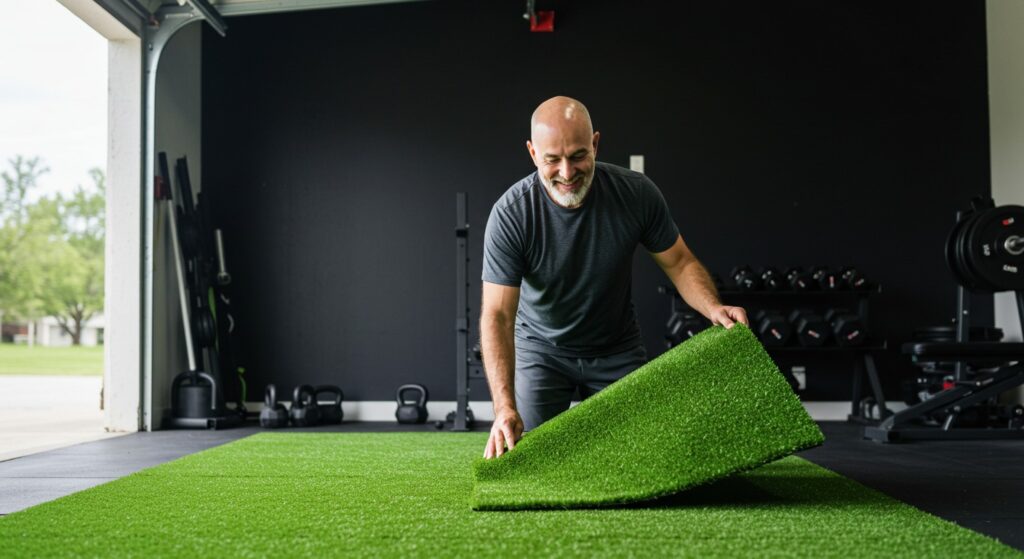
Turf provides a unique surface for functional and sports-specific training with growing popularity.
Best For: Sports-specific training and functional fitness enthusiasts.
Benefits:
- Excellent for sled work and agility training
- Durable even under intense use conditions
- Good drainage properties
- Creates a motivating athletic environment
Drawbacks:
- Less suitable for traditional weightlifting
- Higher cost for quality options
- Requires special cleaning consideration
Top Recommendations:
| Product | Pile Height | Price Range |
| IncStores Turf Tiles | 1-3/8″ | $4.00-$7.00/sq ft |
| TurfLinks Pro Series | Athletic-grade | $4.50-$8.00/sq ft |
IncStores Turf Tiles feature interlocking design, excellent drainage system, and UV-stabilized materials.
TurfLinks Pro Series offers professional-grade synthetic grass, infill-free design, and specialized backing for proper foot traction.
Specialized Solutions for Specific Needs
1. Platform Flooring for Olympic Lifting
For dedicated weightlifters, especially those performing Olympic lifts, specialized platforms offer the best protection and performance.
Benefits:
- Ultimate protection for subfloors against significant impact forces
- Enhanced durability in drop zones where barbells make contact
- Professional gym experience with proper rebound characteristics
- Often incorporates wood and rubber sections for optimal performance
- Creates a psychological “competition space” for serious training
Top Recommendation: PRx Performance Olympic Platform
- Customizable dimensions to fit your available space
- 1.5″ total thickness engineered for maximum protection
- 3/4″ rubber border with maple center section for ideal lifting dynamics
- Competition-grade materials used throughout construction
- Professional installation available for perfect results
Price range: $900-$1,500 for complete platform
DIY Alternative: Many weightlifters construct their own platforms using:
- 3/4″ plywood base layers (typically 2-3 layers)
- 3/4″ top layer of finish-grade plywood
- Horse stall mats for drop zones
Total materials cost: $350-$500 for standard 8’×8′ platform
2. Portable Mats
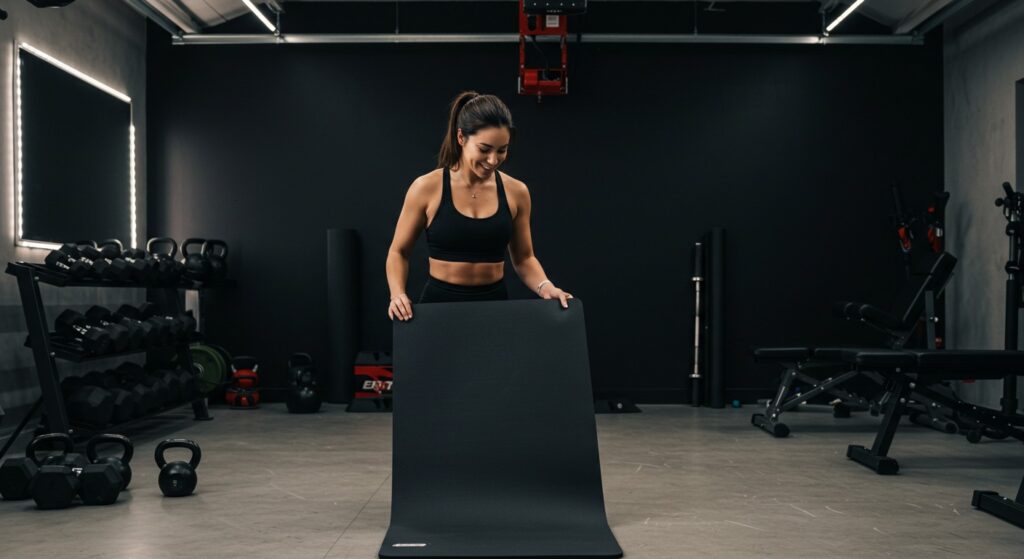
For those with space limitations or rental properties, portable mat options provide flexibility without permanent installation.
Benefits:
- Can be stored away when not in use, maximizing space utility
- Adaptable to different workout styles and changing needs
- Less expensive than full-room solutions for budget-conscious users
- Ideal for renters who cannot make permanent modifications
- Easy to transport when moving to new locations
Top Recommendation: Gorilla Mats Premium Large Exercise Mat
- Available in sizes up to 8’×10′ for substantial coverage
- Non-slip bottom surface prevents dangerous movement during workouts
- 8mm thickness for good protection without excessive bulk
- Includes storage straps and bag for convenient storage
- Dense construction prevents bunching during dynamic movements
Price range: $150-$300 depending on size
Specialized Use Alternative: Square36 Large Exercise Mat
- Extra-large sizing options up to 12’×6′
- Non-toxic materials with low VOC emissions
- Specifically designed for cardio equipment stability
- Dual-sided construction for varied workout surfaces
Price range: $175-$400 depending on size selection
Home Gym Flooring Installation Considerations
DIY vs. Professional Installation
When deciding between self-installation and hiring professionals, consider these comparative factors:
| Factor | DIY Installation | Professional Installation |
| Cost | Lower initial expense | Higher upfront cost |
| Time | Requires personal time investment | Completed quickly |
| Quality | Depends on skill level | Consistent results |
For most foam and interlocking rubber tiles, DIY installation is straightforward. However, for wall-to-wall rubber flooring, vinyl installations, or specialized platforms, professional installation often delivers superior results that justify the additional expense.
Subfloor Preparation
Proper preparation is crucial for long-term performance. According to flooring industry statistics, majority of flooring failures stem from inadequate subfloor preparation.
Essential preparation steps include:
- Thorough cleaning: Ensuring the subfloor is clean and debris-free to prevent unevenness
- Moisture assessment: Checking for and addressing any moisture issues, particularly in basement installations
- Leveling: Addressing uneven areas before installation to prevent rocking or instability
- Underlayment selection: Choosing appropriate underlayment material if needed for additional protection or comfort
- Acclimation: Allowing flooring materials to adjust to room temperature for 24-48 hours before installation
For concrete subfloors, moisture testing using calcium chloride test kits is highly recommended, as excess moisture can cause adhesive failure and mold development beneath your gym flooring.
Home Gym Flooring Maintenance and Care
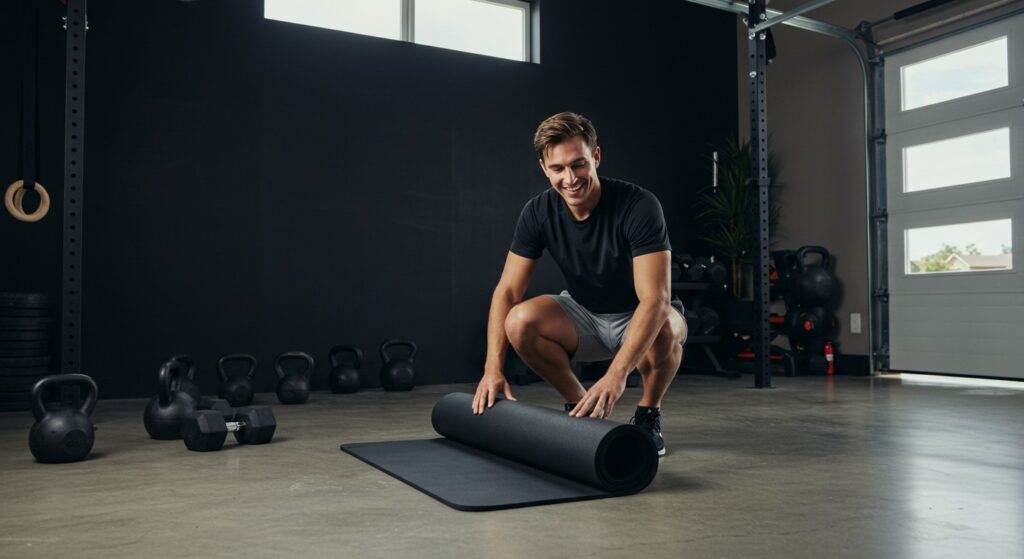
Different flooring options require specific maintenance routines to maximize lifespan and performance:
Rubber Flooring
- Daily maintenance: Regular sweeping or vacuuming to remove abrasive particles
- Weekly cleaning: Occasional mopping with mild soap solution (pH-neutral cleaners recommended)
- Preventative care: Avoid harsh cleaning chemicals, especially petroleum-based products
- Long-term maintenance: Check for and address curling edges or separation between pieces
- Equipment considerations: Use equipment mats under machines that run for extended periods
Foam Tiles
- Daily maintenance: Sweep or vacuum to remove debris that can cause surface damage
- Sanitation: Wipe down with sport-specific disinfectant spray after sweaty workouts
- Damage control: Replace damaged tiles as needed rather than attempting repairs
- Rotation: Periodically rotate tiles from high to low-use areas to extend lifespan
- Prevention: Use equipment mats under weight benches and racks to prevent compression
Vinyl Flooring
- Daily care: Sweeping or dust mopping to remove abrasive particles
- Weekly maintenance: Damp mopping with manufacturer-recommended cleaners
- Protection: Use furniture pads under equipment to prevent indentation
- Caution areas: Avoid abrasive cleaners or steam cleaning which can damage the finish
- Scratch management: Use touch-up kits for minor scratches before they worsen
Carpet Tiles
- Regular vacuuming: At least twice weekly to prevent dirt embedding
- Spot cleaning: Immediate attention to spills or sweat spots
- Deep cleaning: Professional extraction cleaning every 12-18 months
- Rotation: Switch tiles from high to low-traffic areas annually
- Replacement: Keep extra tiles on hand for quick replacement of damaged sections
Making the Final Decision
Consider these questions when making your final selection:
- What is your primary workout style? Be honest about your actual (not aspirational) fitness routine.
- How permanent is your gym setup? Temporary spaces need different solutions than dedicated rooms.
- What is your realistic budget per square foot? Factor in both materials and installation costs.
- How important are aesthetics versus functionality? This balance varies greatly between individuals.
- Do you need zoned flooring for different activities? Mixed-use spaces often benefit from varied surfaces.
- What is beneath your gym space? Neighbors below require different considerations than concrete slabs.
- How will your fitness needs evolve? Choose flooring that accommodates your fitness growth.
Conclusion
Investing in quality home gym flooring protects both your property and your body during workouts. Whether you choose rubber, foam, vinyl, or another option, select materials that align with your specific exercise needs and space considerations.
Remember that proper flooring is an investment in your fitness journey—one that will support you through countless workouts while protecting your home and enhancing your exercise experience.
Home Gym Flooring FAQs
How thick should home gym flooring be?
For general fitness, 8mm is sufficient. For weightlifting, choose 3/8″ to 3/4″ thickness.
Can I put gym flooring over carpet?
Yes, but use firmer options like rubber tiles rather than foam to prevent instability.
How do I eliminate rubber flooring odor?
Air out new flooring in a garage or outdoor space before installation, then clean with a vinegar solution.
Is underlayment necessary with gym flooring?
Not always—rubber and thick foam options often don’t require additional underlayment.
How long does quality gym flooring last?
Premium rubber flooring can last 10-15 years with proper care, while foam options typically need replacement after 3-5 years.

